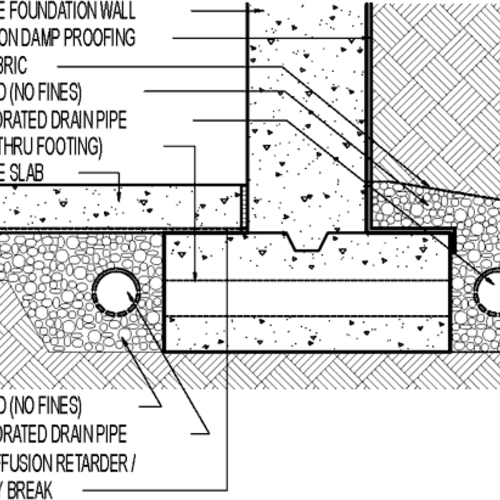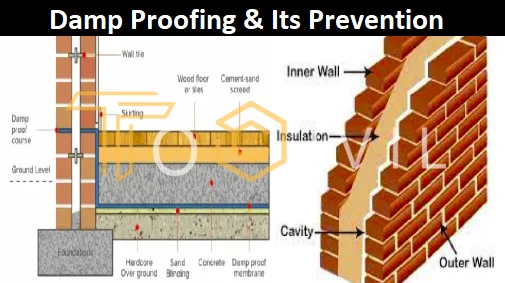Discovering the Various Methods and Solutions for Effective Damp Proofing
Dampness in structures presents considerable challenges to both architectural honesty and indoor air quality. Different techniques and services have emerged to fight this prevalent concern. From traditional damp-proof membranes to ingenious chemical therapies, each method offers distinct advantages. Comprehending these alternatives is vital for reliable moisture control. Selecting the appropriate service depends on certain structure conditions and needs, motivating more expedition into the most effective wet proofing approaches readily available.
Comprehending the Reasons For Wetness
Wetness can develop from different sources, comprehending these reasons is important for effective removal. Frequently, dampness stems from three primary resources: rising damp, penetrating wet, and condensation. Increasing damp takes place when groundwater takes a trip upwards via porous products, such as block or stone, typically due to a lack of an effective obstacle (damp proofing newcastle). Penetrating wet is typically triggered by exterior factors, consisting of roofing system leakages, faulty gutters, or damaged walls, permitting water to infiltrate a residential property. Condensation, on the other hand, results from excess dampness airborne, typically intensified by bad air flow and temperature differences, bring about water beads basing on surfaces. Determining these underlying issues is crucial, as each kind of moisture calls for a tailored technique for removal. Proper assessment assists in determining the most reliable services, eventually safeguarding the architectural integrity of a structure and enhancing interior air high quality
Standard Damp-Proof Membrane Layers

Chemical Damp-Proofing Solutions
Chemical damp-proofing services provide an innovative technique to stop moisture intrusion in buildings. These approaches normally entail the application of liquid chemicals that penetrate masonry and create an obstacle versus rising moist. Generally utilized chemicals include silanes, siloxanes, and other water-repellent agents that react with surface area products to produce a hydrophobic layer.The application procedure typically requires drilling openings into the walls, infusing the chemical remedy, and enabling it to treat. This approach is specifically helpful for older structures where traditional damp-proof membranes might be not practical. Chemical damp-proofing can be much less disruptive and extra economical than extensive improvement projects.While efficient, these options depend on proper application and ecological conditions for peak efficiency. damp proofing newcastle. Normal upkeep and monitoring are important to guarantee the long life of the damp-proofing treatment. Overall, chemical damp-proofing stands for a functional choice for guarding structures versus moisture-related damages
Tooth Cavity Wall Building And Construction Methods
Dental caries wall building methods supply various advantages, particularly in wetness control and power effectiveness. By integrating an air space in between 2 layers of masonry, these wall surfaces properly minimize water ingress while enhancing insulation. This mix not just protects frameworks from moisture yet also adds to decreased power usage.
Advantages of Tooth Cavity Wall Surfaces
When thinking about efficient wet proofing techniques, the advantages of dental caries wall surfaces stick out plainly. Dental caries wall surfaces consist of two separate layers, producing an air void that efficiently minimizes wetness infiltration. This design reduces the danger of moisture, as the external wall acts as a barrier versus rainfall and water access. Furthermore, tooth cavity walls improve thermal insulation, which adds to power performance by lowering warmth loss. They also provide audio insulation, aiding to develop a quieter interior setting. The air space allows for air flow, which helps in wetness control and decreases the probability of mold growth. These advantages not only enhance the overall comfort of a building yet also add to its longevity and architectural integrity.
Moisture Control Approaches
Reliable dampness control techniques are crucial in tooth cavity wall building and construction to guarantee long-lasting defense against moisture. One key method involves the consolidation of weep openings, which help with water drainage from the dental caries, stopping buildup. Additionally, the usage of breathable membrane layers can assist take care of dampness levels while permitting trapped vapor to get away. Correct placement of insulation is likewise essential, as it ought to not block water drainage paths. Additionally, making certain that the outer fallen leaves of the dental caries wall are built with waterproof products boosts overall toughness. Normal maintenance checks are necessary to determine any kind of obstructions or damage early, safeguarding the framework's honesty. Eventually, a combination of these strategies develops a robust defense versus dampness breach in dental caries wall surfaces.
Insulation and Power Effectiveness
Insulation plays a crucial duty in enhancing energy effectiveness within dental caries wall surface building and construction. By incorporating protecting materials, these wall surfaces create a thermal obstacle that lessens heat loss and minimizes energy intake. Efficient insulation not only helps keep a steady indoor temperature but additionally minimizes the threat of moisture, as it prevents condensation within the wall surface tooth cavity. Various strategies, such as making use of rigid foam boards or mineral woollen, can be utilized to achieve ideal insulation efficiency. Furthermore, proper installment is important to assure that gaps and voids are decreased, which can otherwise compromise power effectiveness. Eventually, a well-insulated cavity wall surface adds significantly to total sustainability and decreases cooling and heating expenses for property owners.
External Damp Proofing Methods
External wet proofing techniques are important for shielding structures from wetness seepage. Two reliable techniques consist of damp removal newcastle the application of water resistant membranes and the setup of French drains pipes. These solutions assist mitigate water build-up and maintain the integrity of buildings.
Waterproof Membrane Layer Application
While different approaches exist for preventing wetness ingress, the application of water-proof membranes stays a very effective outside wet proofing method. These membrane layers are typically made from materials such as polyethylene, rubber, or changed bitumen, supplying a robust obstacle versus water penetration. The setup procedure includes applying the membrane to the exterior surface areas of walls or foundations, making sure full insurance coverage to avoid leaks. Proper adhesion and securing at joints are essential to making the most of performance. Water resistant membranes can be applied in numerous types, consisting of liquid coatings and sheet membrane layers, enabling for versatility based on the specific requirements of the framework. This method not only safeguards buildings from dampness but also boosts their long life and architectural honesty.
French Drainpipe Setup
One efficient method for managing groundwater and preventing dampness buildup around a structure's foundation is the setup of a French drainpipe. This drain system is composed of a trench loaded with crushed rock and a perforated pipeline that reroutes surface water away from the foundation. Correct installment calls for cautious planning, guaranteeing that the drain slopes away from the structure to help with perfect water flow. In addition, the area of the drain is important; it should be positioned in areas vulnerable to merging or excess wetness. Regular maintenance, consisting of clearing up particles from the gravel and making certain the pipe continues to be unblocked, is necessary for long-lasting effectiveness. Eventually, a well-installed French drain can substantially decrease the threat of water-related problems in structures and cellars.
Interior Waterproofing Methods
Interior waterproofing methods are vital for securing a building's interior from dampness infiltration and possible water damage. These techniques typically include the application of specialized products and techniques made to produce a dampness barrier within the framework. One common strategy is the usage of water resistant coatings or sealants on wall surfaces and floors, which stop dampness from permeating surfaces.Additionally, installing interior water drainage systems, such as sump pumps, can efficiently take care of water accumulation in cellars and crawl areas. Another technique entails making use of vapor obstacles, which are installed to prevent moisture motion from the ground into living spaces.Moreover, attending to any cracks or voids in wall surfaces or foundations with ideal sealers assures a comprehensive protection against water intrusion. By executing these interior waterproofing methods, homeowner can greatly reduce the risk of mold growth, structural damages, and various other moisture-related concerns. Correct implementation of these methods is necessary for long-term protection and structure honesty.
Routine Maintenance and Evaluation Practices
Regular maintenance and examination methods are essential for assuring the long-lasting performance of moist proofing services in any building. Routine checks enable homeowner to identify very early indications of wetness invasion, such as peeling off paint, mold and mildew growth, and mildewy smells. These signs can signal underlying concerns that require prompt attention.Inspections must be carried out at the very least each year, concentrating on susceptible locations like basements, creep rooms, and exterior wall surfaces. During these assessments, homeowner should analyze sealers, drain systems, and ventilation to validate they work correctly.Additionally, maintaining seamless gutters and downspouts is vital, as clogged systems can cause water accumulation near the structure. Executing a normal maintenance routine, in addition to timely repair work, can substantially expand the life expectancy of wet proofing procedures and protect the architectural stability of the structure. Positive measures inevitably add to the total health and wellness of the living atmosphere.
Frequently Asked Concerns
For How Long Does Damp Proofing Generally Last?
The period of moist proofing performance differs, commonly lasting in between 20 to 50 years. Aspects such as application quality, ecological problems, and maintenance techniques substantially influence the long life of the moist proofing treatment.

Can I Damp Proof My Home Myself?
The specific pondered the expediency of do it yourself damp proofing. With appropriate research and the right products, it is feasible. Nevertheless, they also identified the relevance of expert assistance to assure resilient efficiency and prevent future concerns.
What Are the Indicators of Inefficient Damp Proofing?
Signs of inefficient damp proofing include relentless stuffy odors, visible mold and mildew growth, peeling off paint, damp patches on wall surfaces, and timber decay - damp specialist newcastle. Property owners must resolve these problems without delay to avoid additional damages and health and wellness worries
Does Damp Proofing Affect Indoor Air Top Quality?

Just How Much Does Professional Damp Proofing Price?
Specialist damp proofing expenses differ substantially, normally varying from $1,000 to $5,000 depending on the property's size, the degree of the wet issue, and chosen techniques. Each circumstance calls for a tailored assessment for precise rates. Commonly, wetness originates from three main resources: climbing wet, penetrating damp, and condensation. When thinking about reliable wet proofing methods, the advantages of tooth cavity wall surfaces stand out plainly. Exterior wet proofing techniques are crucial for protecting structures from moisture seepage. While various approaches exist for avoiding dampness ingress, the application of water-proof membrane layers continues to be a very reliable exterior damp proofing technique. Signs of ineffective damp proofing include persistent moldy odors, noticeable mold and mildew development, peeling paint, moist patches on walls, and wood degeneration.